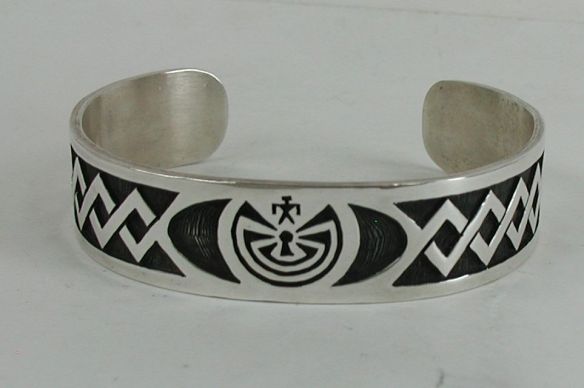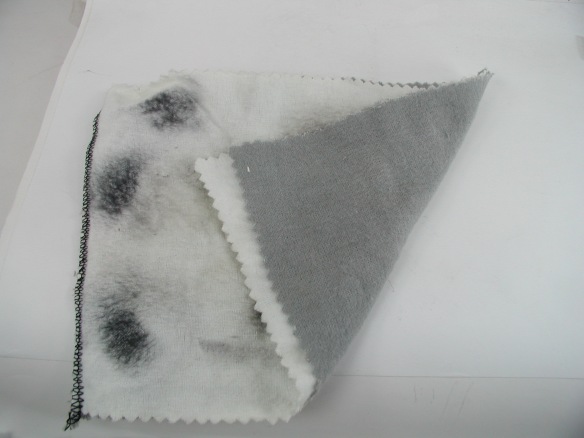We sell many used and vintage pieces that have from light to heavy patina and tarnish on them. We leave the choice of whether to polish or not to the customer.
Patina is the overall uniform darkening that occurs from aging. Patina adds a richness to vintage pieces. How much patina you like is personal preference, there is no right or wrong.
Tarnish, on the other hand, is a thin dirty film that appears on silver as it oxidizes. Tarnish, in my opinion, should be remove regularly using a mild method, such as with a buffing cloth. Each of these pieces took about one minute to fully polish with a cloth.
Here is one of my favorite contemporary Hopi Man in a Maze bracelets (by Cyrus Josytewa) before buffing. Basically a dirty bracelet !
Hubby’s favorite buckle (Stanley Gene, Navajo) has some nice patina and also has tarnish. I’m on the fence with this piece – I actually think I prefer the overall patina but he volunteered it for an example. A buckle makes contact with a lot of surfaces so even after the tarnish is removed, the buckles still has its character scratches.
Here are some more articles related to jewelry care:
Are you supposed to polish Navajo Pearls?
Cleaning Vintage Native American Jewelry
A reminder about jewelry polishing cloths
Paula








I enjoy reading your blogs and visiting your store! Here is my opinion on the subject of polishing and ‘patina’. Apparently ‘Patina’ has become the beat all no fail buzzword in this industry these days to entice a potential buyer into thinking the piece is indeed very old, nonsense I say.
Sellers of silver jewelry of all types, particularly Native American will state ‘the piece shows or has great patina or my favorite one, ‘warm patina’ yet the piece is black as coal, so I always wonder how do they know the piece has a warm patina if they can’t see it? Some sellers of Native American jewelry have this word in describing just about everything they sell, or the other terms ‘Old Pawn or Dead Pawn’, but that can wait for another blog on that subject. Websters Dictionary has more than one definitions for the noun ‘Patina’ depending on its use in a sentence, I will use Webster’s definition part ‘b’ for this reply addressing Patina, Tarnish, and To clean or not to clean silver jewelry. Websters Dictionary part ‘b’ defines patina as, “a surface appearance of something grown beautiful especially with age or use”, 99% of the time you can not see the patina because the piece is black with ‘Tarnish’ from oxidation, apparently ‘patina’ is often conflated with the presence of tarnish. The age of a piece cannot be determined just because it appears black with tarnish, tarnish is due to oxidation that occurs when oxygen (air) makes contact with the metal, and the lack of removing such by cleaning and polishing, it is not indicative of age nor is patina solely indicative of age, only wear and use. Oxidation is just the transfer of electrons from one thing to another, with silver, it occurs as the chemicals/elements when exposed to ‘oxygen’ change to form a by-product which is black and we know as tarnish. Silver cleaners just reverse this process, and remove the tarnish, often there is an odor when this is done, but that is another chemistry lesson. Patina in of itself describes the ‘warmth’ or ‘beauty’ a piece of silver has acquired over time due to A lot of use, the ‘scratches’ are no longer discernable as scratches since the surface is no longer ‘shiny’, and as such, they have changed the surface forever unless someone gets out the jewelers rouge and other compounds to buff the piece and bring it back to a mirror-like shiny surface. Silver is unique in that over time as it develops a warm glow or ‘patina’, this is unique to silver as dull gold or platinum is not pretty at all. Patina is desirable but does not always indicate ‘age’, only ‘use’. The same piece of silver that is only 5 years old worn constantly could develop the same patina as the piece that is 50 years old. Especially if the newer piece is worn constantly and polished regularly, this new piece could look like a vintage piece of silver in a very short time. I ‘polish’ and clean my jewelry and stones, as I cannot remove ‘patina’ by cleaning and hand polishing it, only the crude that has built up over time, old silver cleaner in crevices, food, and other unmentionables, I want to clean them off the piece. Leaving this stuff in and on a piece can actually harm the silver and stones if present, it is not beneficial at all. Too remove a well worn warm patina and bring it back to a high shine requires more than hand cleaning and polishing, it takes Jewelers Rouge, Zap, Fabuluster or other compounds, buffing clothes a lot of elbow grease or a Drummel tool or larger piece of equipment, in addition, the knowledge on how to ‘buff out’ a piece of metal. Ergo, cleaning or normal polishing of silver to remove tarnish is not going to ruin the patina on a piece. So, why do most sellers emphatically state “we do not polish or we do not clean our pieces”? I have read sellers statements such as “We do not clean or polish our Native American jewelry because we feel this ruins the beauty of the piece”, I beg to differ. Is the piece black as night in the listing, because if it isn’t, they cleaned and polished it or received it cleaned then hermetically sealed the piece to avoid contact with ‘the air’. My thoughts are ‘what are they hiding and why don’t they take the time to clean their jewelry’, not ‘oh my that piece of over tarnished black and turquoise jewelry is stunning and must be so old’. I still purchase tarnished jewelry, but I clean it thoroughly to get a good look at it to determine if it is fact worth keeping. There is nothing wrong with cleaning your silver, in fact, it is my opinion that if an artist wanted their labor of love, their work to be black they would have used Liver of Sulphur and oxidized the surface to darken it, or they would have made it out of Cast Iron, not silver. I want my silver to have that beautiful luster and or patina visible, I don’t care too wear black silver jewelry. The best galleries and museums like the Smithsonian do not display ‘black’ silver works of art/jewelry unless of course, it has to be left that way for some reason known to the curator.
Personally, after taking a 60x lighted loupe to a ‘tarnished’ and neglected piece, and seeing what is encrusted there, well I am gonna clean it, I am not putting that on my skin without cleaning it, period. I have found food, tiny hairs, skin, old silver polish, and did I say food, yes mustard, acidic silver eating mustard! Plus, I have discovered after cleaning a piece that the artist applied details like a fine silver twist rope that had been obliterated from view, and the process of cleaning the piece brought up details that were otherwise not visible prior to cleaning. I feel that cleaning and hand polishing my pieces also ‘honors’ the artists work, the beauty of the silverwork is revealed. It is a lot of work when you have hundreds of pieces but it is worth the time, I am the caretaker of the work of art, which I believe includes keeping it clean, full of luster and beauty. I also clean the surface of the stones because leaving lotions, oils, and other ‘stuff’ on stones are not good for them. I never submerge or over wet turquoise or other softer stones because even though they will dry, most have a cushion layer under the stones to absorb ‘shock’ so the stones don’t crack, these substances can absorb water, swell, lift and pop the stone out of the setting, corks especially are notorious for this if they get soaking wet. Also, if allowed to remain wet for a prolonged period will over time pull copper out of the silver leaving behind a green by-product of oxidized copper. All that is required is a little water a small soft brush and a tiny, and I emphasize the word ‘tiny’ bit of uncolored, non-lotion containing Dawn (which contains a surfactant); the surfactant will change the surface tension of the water disperse the grease, and makes lifting the oils and other oil-based substances easier to remove from the surface, just be careful to remove all the Dawn. I also use professional jewelry cleaners that are deemed safe for stones, just do not submerge or soak the stones as you would say a diamond, and you should be ok. So, I clean and hand polish my silver jewelry, I am careful to always turn the cloth to use a new area when polishing as the ‘black’ on the cloth will scratch the piece if rubbed into the silver and this can leave marks that you do not find appealing. I gently wash stones, and this is ok, think of it this way, if you are wearing a cherished piece of silver jewelry and you are caught out in the rain, do you take off the jewelry or run for cover, I think not. Patina should not be conflated with tarnish or age, it is the warm luster silver develops over time from use and wear, it indicates the piece was worn and used a lot. Buyers need to do be vigilant and do their homework, ask questions of the seller, and always ask for a receipt that states the facts related to the piece. Be wary when a seller conflates ‘patina’ with age, and/or has a misleading statement “We do not clean our pieces of Native American jewelry”, ask them why they don’t, the answer they give will reveal a lot about the seller, but not necessarily the age of the piece of jewelry. In closing this reply, Patina is from use, not necessarily age, and not cleaning a visibly tarnished and dirty piece does not necessarily devalue the piece, quite the opposite in my opinion. If you can’t see the artists work then what is the point?
Yes, I agree !!!
Paula